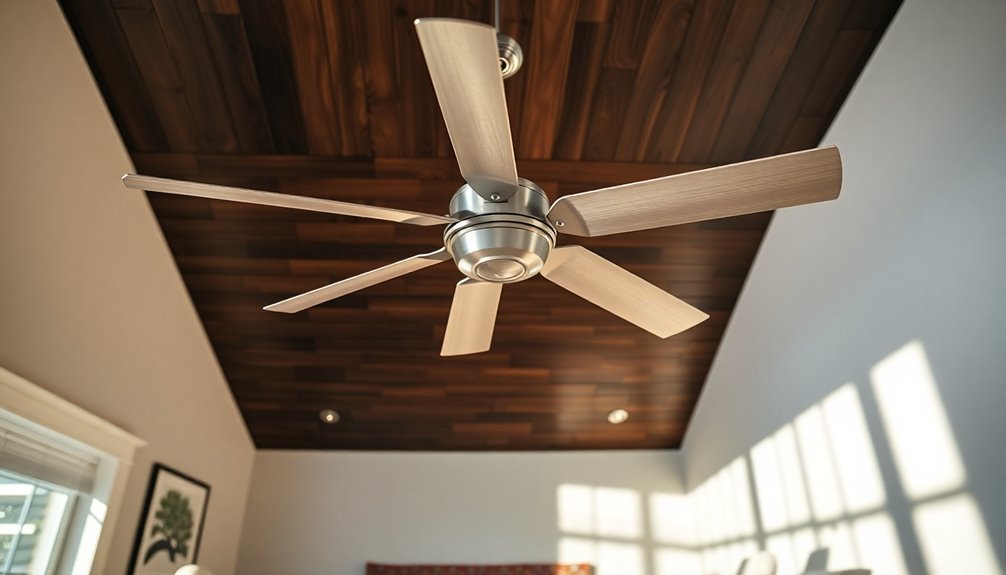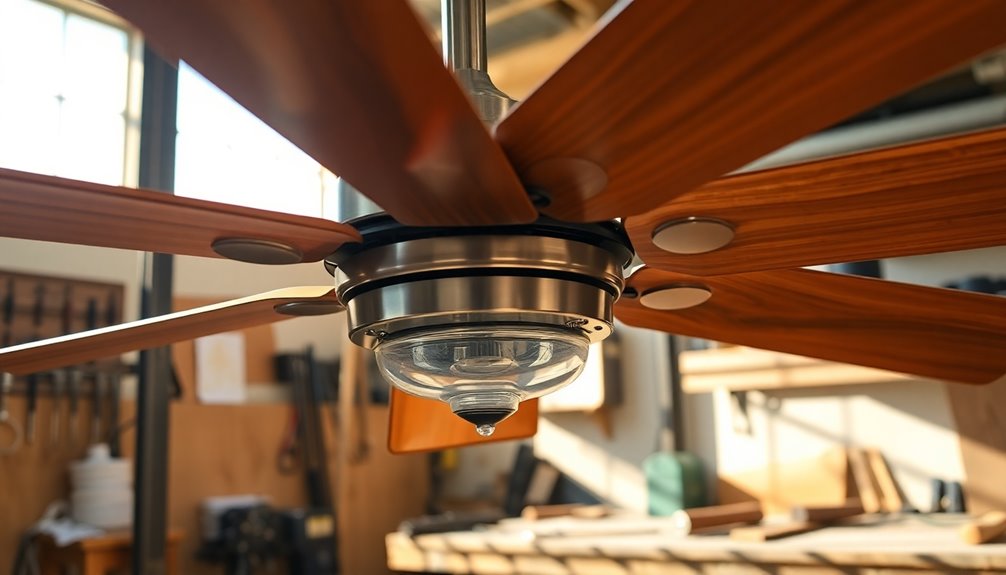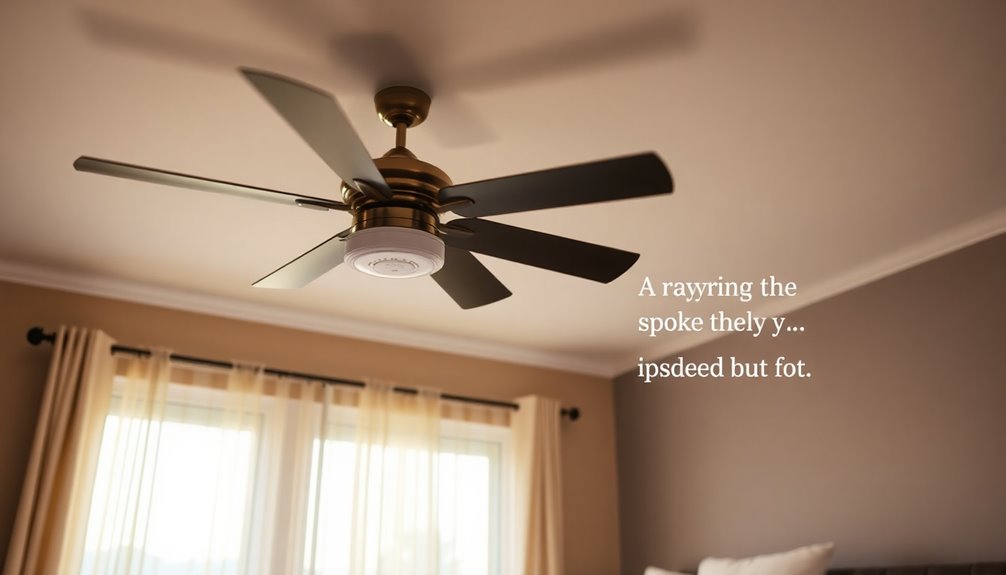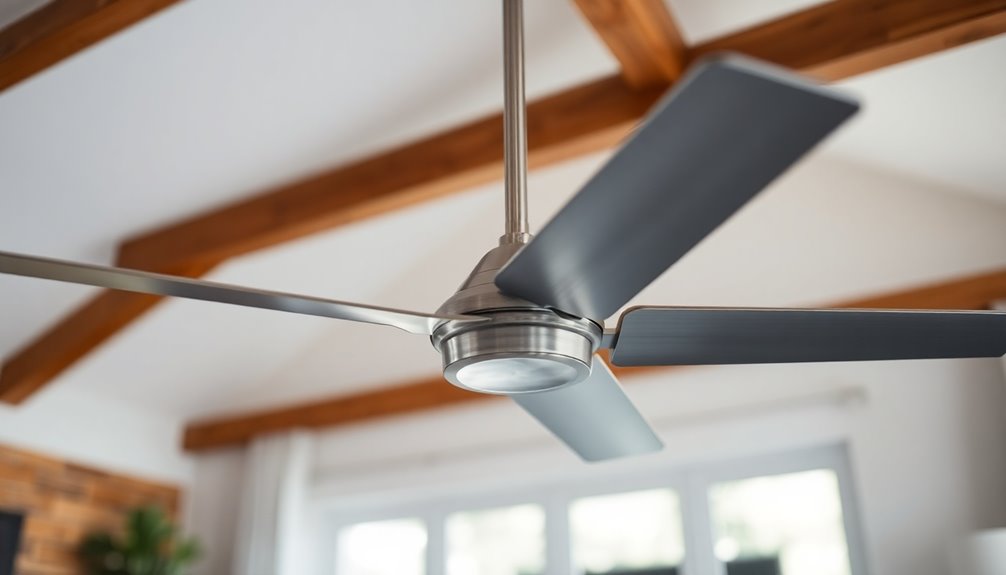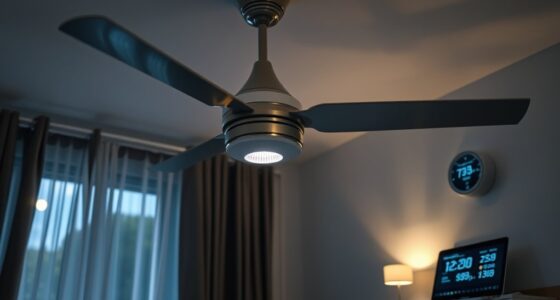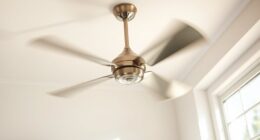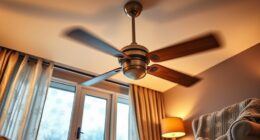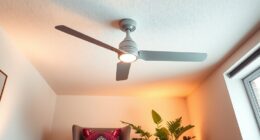Your ceiling fan should hang at least 7 feet above the floor to avoid accidents and guarantee good airflow. Ideally, aim for a height between 8 to 9 feet for comfort and efficiency. If your ceiling is under 8 feet, take into account a flush mount fan. For ceilings over 14 feet, use longer downrods to properly position the blades at that ideal height. Maintaining an 8 to 10 inches gap from the ceiling helps enhance air circulation and minimize noise. Be certain to take into account all these factors carefully, and you'll soon discover how to achieve the best setup for your space.
Key Takeaways
- Ceiling fans should hang at least 7 feet above the floor to prevent injuries.
- The ideal height for fan blades is between 8 to 9 feet for effective airflow.
- Maintain an 8 to 10 inch distance from the ceiling for optimal circulation and noise reduction.
- For ceilings over 14 feet, use downrods between 36 to 72 inches to ensure proper blade height.
- Always comply with local building codes for safety and performance standards.
Ceiling Fan Height Guidelines
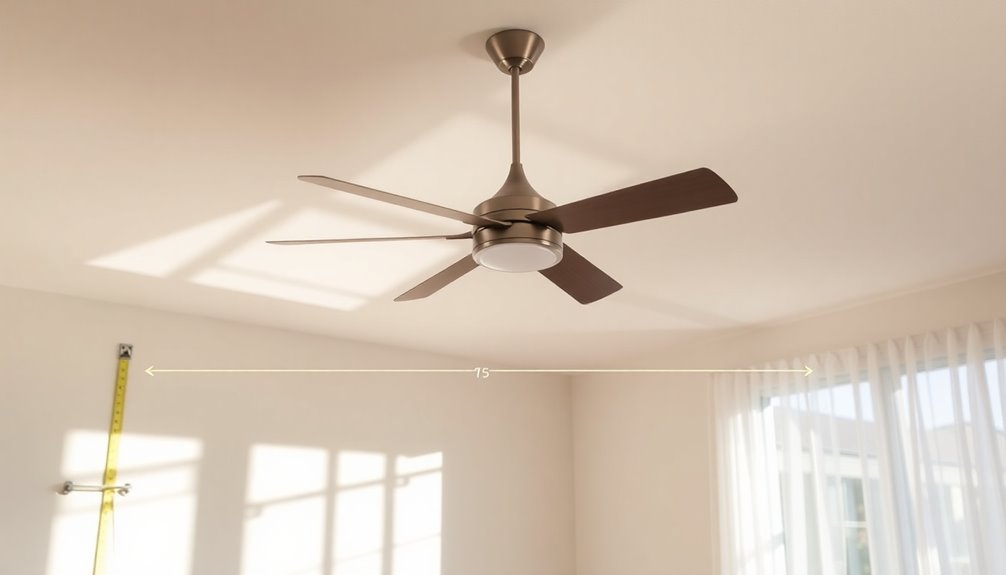
When it comes to ceiling fan height guidelines, proper installation is vital for both safety and comfort. You should aim for a ceiling fan height where the blades are at least 7 feet above the floor. This minimum distance prevents injury and guarantees safe clearance.
The ideal height for ceiling fan blades is typically between 8 to 9 feet above the floor. This height provides effective airflow and comfort, making your space more enjoyable.
When installing a ceiling fan, it's also important to take into account how far the fan hangs from the ceiling. Ideally, fans should hang 8 to 10 inches from the ceiling to maximize proper air circulation and minimize noise.
If your ceiling height exceeds 14 feet, you'll need a longer downrod—between 36 to 72 inches—to maintain the recommended downrod length and guarantee the fan operates efficiently.
For rooms with ceilings under 8 feet, think about flush mount fans. These options give you adequate air circulation without compromising safety.
Keeping these ceiling fan height guidelines in mind will help you create a comfortable environment while making sure you adhere to safety standards.
Importance of Downrod Length
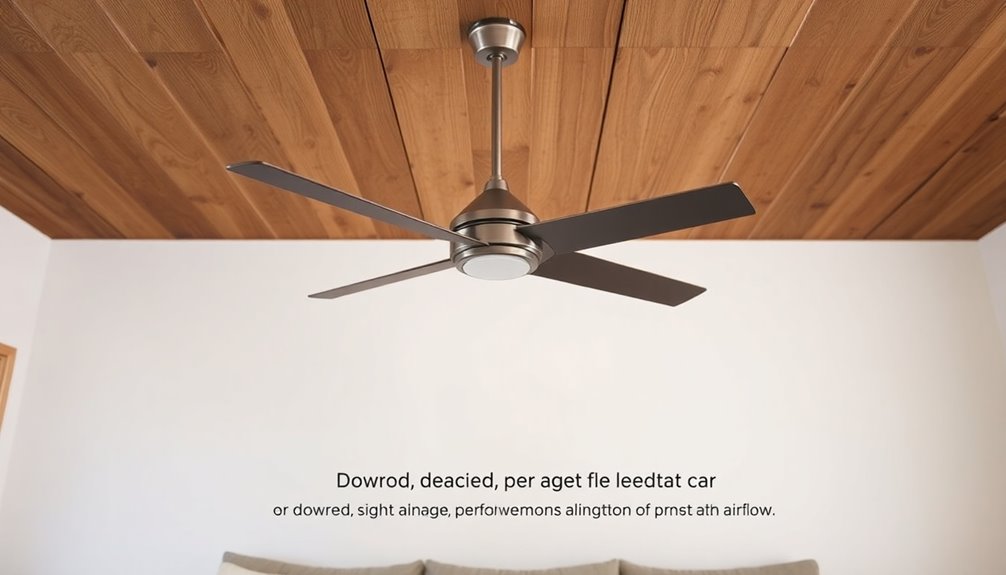
Proper downrod length plays an essential role in ensuring your ceiling fan operates effectively. To achieve ideal height, ceiling fan blades should be positioned 8 to 9 feet above the floor. This height promotes efficient airflow, enhancing comfort throughout the room.
Additionally, proper downrod sizing is critical for preventing safety hazards; blades need to be at least 7 feet above the floor to avoid accidental contact.
For ceilings taller than 14 feet, consider a longer downrod, typically ranging from 36 to 72 inches. This extra length helps maintain adequate air circulation.
Keep in mind that the distance between the fan blades and the ceiling should be about 8 to 10 inches to minimize noise and maximize airflow efficiency.
Incorrect downrod length can lead to ineffective airflow, causing discomfort and increasing energy costs due to poor circulation. As a result, it's crucial to calculate the appropriate downrod size carefully.
Achieving visual balance in your space is another benefit of proper downrod length; a well-hung fan complements your room's aesthetics while providing the right airflow.
Safety Considerations for Ceiling Fans

When installing a ceiling fan, you need to guarantee it hangs at least 7 feet above the floor to avoid any accidental injuries.
If it's too low, you risk obstructing movement and increasing the chances of accidents.
On the other hand, hanging it too high can reduce airflow efficiency, so proper installation height is essential for safety and performance.
Minimum Height Requirement
Ceiling fans play an essential role in keeping your space comfortable, but their installation height is important for safety. To guarantee a safe environment, you need to adhere to the minimum height requirement for ceiling fans.
Here are some key points to keep in mind:
- Fan Blade Height: Install ceiling fan blades at least 7 feet above the floor to prevent injuries.
- Ideal Height: Aim for an ideal height of 8 to 9 feet to enhance airflow efficiency and minimize noise.
- Avoid Low Installations: Installing the fan too low increases the risk of contact with people, especially in busy areas, which can create potential hazards.
- Check Local Codes: Always comply with local building codes, as they may specify particular height requirements for ceiling fan installations.
Risks of Improper Installation
Improper installation of a ceiling fan poses significant safety risks that can lead to serious injuries. When a fan hangs too low, it can create hazards, especially in high-traffic areas where people might inadvertently come into contact with the blades.
To comply with safety standards, ceiling fan blades must be at least 7 feet above the floor. Failing to meet this requirement not only increases the risk of head injuries but can also obstruct movement in busy rooms, leading to potential falls or damage to the fan.
Additionally, a ceiling fan installed too low can cause wobbling issues, which presents further safety concerns and operational inefficiencies. Proper installation height is essential for ensuring ideal airflow and cooling system performance.
Ideally, your fan should be positioned between 8 to 9 feet above the floor, allowing it to function effectively while minimizing risks. By adhering to these guidelines, you can create a safer environment for everyone in your home.
Make sure to assess the height of your fan to avoid these potential dangers and enjoy the cooling benefits it provides.
Optimal Airflow and Efficiency

The ideal height of your ceiling fan plays an essential role in achieving efficient airflow and maximizing comfort in your space. To guarantee superior airflow and cooling effectiveness, consider these key factors:
- Height of the Ceiling: For ceilings between 8 to 9 feet, the fan blades should sit about 7 to 9 feet above the floor.
- Downrod Length: Calculate the appropriate downrod length by subtracting the desired height of the fan blades (around 8 feet) from the total height of the ceiling.
- Distance from Ceiling: Hang the ceiling fan 8 to 10 inches from the ceiling to minimize noise and enhance airflow efficiency.
- Safety Considerations: Installing the fan too low can increase accident risks, while positioning it too close to the ceiling can lead to decreased airflow and potential wobbling.
Seasonal Usage Recommendations
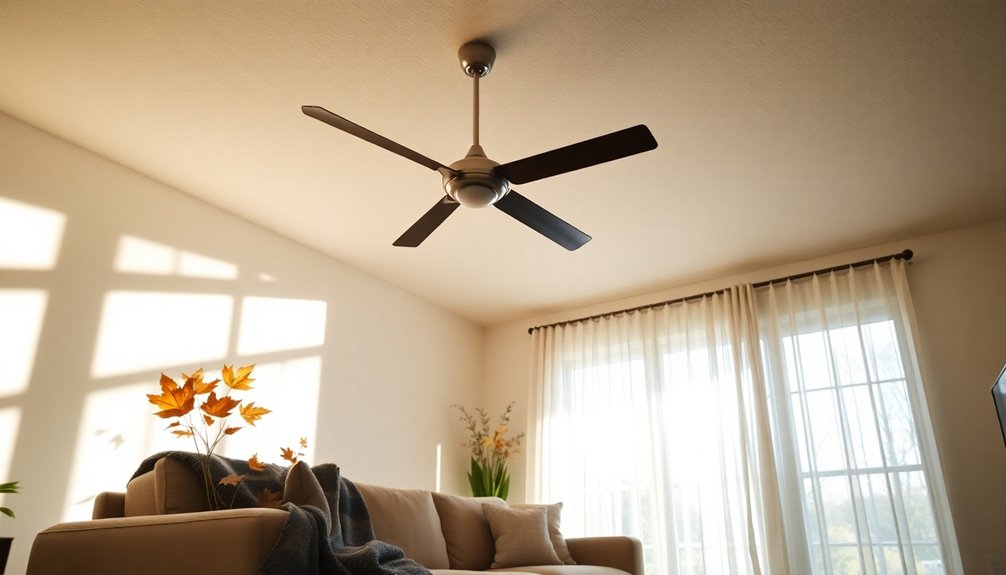
When it comes to using your ceiling fan, the height matters for both summer and winter.
In the summer, aim for a height that cools effectively, while in the winter, adjust it closer to the ceiling to help circulate warm air.
For year-round efficiency, keep a simple rule in mind to guarantee peak performance no matter the season. Optimal air circulation is crucial for making the most out of your ceiling fan's functionality.
Summer Cooling Height
To maximize your comfort during hot summer months, it's crucial to position your ceiling fan blades at the right height. For the best summer cooling, aim for a blade height of 8 to 9 feet above the floor. This guarantees proper airflow and enhances cooling efficiency.
Here are some key points to keep in mind:
- Distance Between the Ceiling: Maintain a distance of 8 to 10 inches between the fan blades and the ceiling. This allows for efficient air circulation without obstruction.
- Ceiling Height: If the height of your ceiling exceeds 9 feet, you'll need a ceiling fan downrod to achieve the perfect blade height.
- Downrod Length: For ceilings measuring 10 feet, a downrod length of about 12 inches is ideal to maintain that recommended blade height.
- Safety First: Always maintain a minimum height of 7 feet from the floor to the fan blades to prevent safety hazards.
Winter Heating Position
For ideal winter heating, adjusting your ceiling fan's position is key to enhancing comfort and efficiency. To guarantee your fan operates effectively, keep the fan blades at least 8 to 9 feet above the floor. This height allows the fan to move air properly without causing discomfort. If you have a low ceiling, use a downrod length that keeps the blades high enough to facilitate warm air circulation.
During winter, set your fan to rotate clockwise. This direction helps push warm air down from the ceiling, increasing the room temperature and making your heating system more efficient, potentially reducing heating costs by up to 15%.
Here's a quick guide to help you determine the correct setup:
| Fan Position | Recommended Height |
|---|---|
| Downrod Length | 1 to 2 feet below ceiling |
| Blade Height | 8 to 9 feet above the floor |
| Clearance from Sloped Ceilings | At least 18 inches |
| Rotation Direction | Clockwise |
| Efficiency Improvement | Up to 15% |
Year-Round Efficiency Tips
Adjusting your ceiling fan's settings throughout the year can greatly enhance comfort and reduce energy costs. To achieve ideal hanging height, consider the following tips for year-round efficiency with your indoor ceiling fans:
- Summer Setup: Hang your fan 8 to 9 feet above the floor. Set it to rotate counterclockwise to maximize cooling efficiency during hot months.
- Winter Position: For winter, raise your fan closer to the ceiling, ideally just a couple of feet down. This promotes gentle air circulation to redistribute warm air effectively.
- Blade Clearance: Verify the fan blades are 8 to 10 inches away from the ceiling to promote effective airflow while minimizing noise.
- High Ceilings: If your room has high ceilings (over 14 feet), use longer downrods (36 to 72 inches) to maintain the right downrod length for proper blade height and improved air circulation.
Aesthetic Factors in Installation
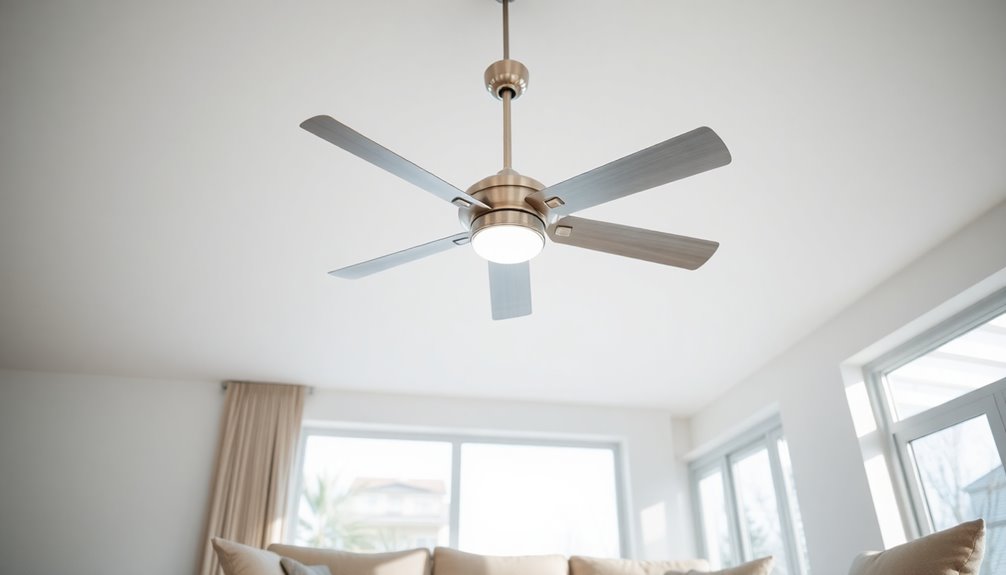
Choosing the right height for your ceiling fan can greatly impact the room's overall aesthetic. Ideally, you want the fan blades to hang 8 to 9 feet above the floor. This height guarantees proper air circulation while maintaining a visually appealing balance in the space.
If you position the fan at least 7 feet above the floor, you prevent obstruction and enhance safety without sacrificing style.
When selecting the right downrod for your fan, consider one that complements its style and finish. A well-matched downrod contributes to a cohesive look, making the fan an integral part of your room's decor.
Additionally, maintaining a distance of 8 to 10 inches from the ceiling can optimize airflow while keeping the fan from feeling too close to the ceiling.
Don't forget about decorative elements, like ceiling medallions, which can further elevate the visual impact of your fan installation. These accents can draw attention to your fan and enhance the overall design.
Choosing the Right Ceiling Fan
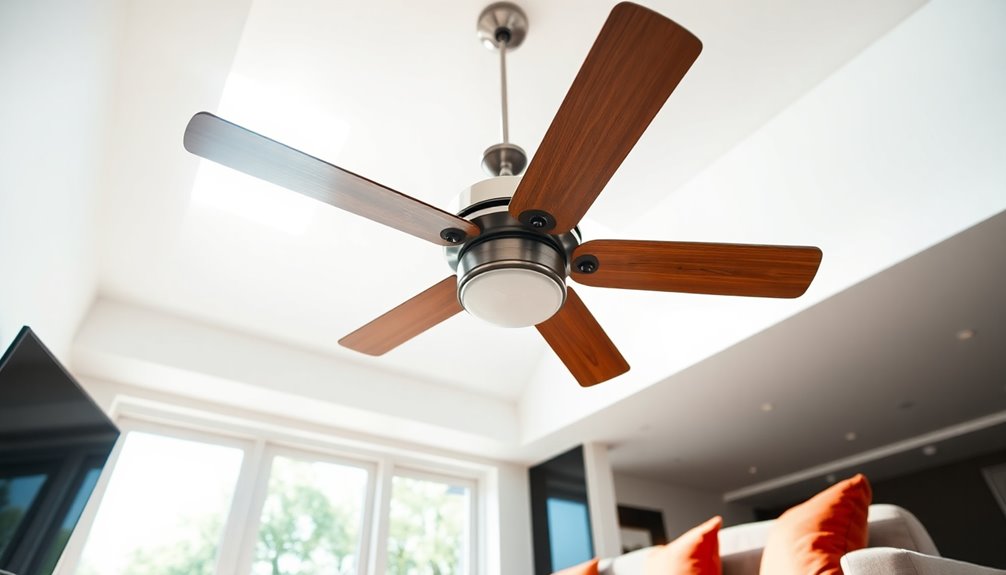
When selecting a ceiling fan, it's essential to take into account both functionality and style to guarantee it meets your needs and enhances your space.
The right ceiling fan downrod plays a significant role in achieving ideal airflow and cooling air throughout the room. Here are some tips to help you choose:
- Ceiling Height: For standard ceilings of 8 to 9 feet, aim for a downrod length of 6 to 12 inches, making sure the blades are at least 7 feet above the floor.
- Room Dimensions: If your ceiling height exceeds 10 feet, consider a downrod of around 12 inches to maintain that perfect height of 8 to 9 feet for the fan blades.
- Higher Ceilings: For ceilings taller than 14 feet, you may need a downrod of 36 to 72 inches to guarantee effective air circulation.
- Aesthetic Match: Confirm the downrod length and fan style complement your room's design without obstructing movement or creating safety hazards.
Frequently Asked Questions
How Far Down Should a Ceiling Fan Hang From the Ceiling?
When you're thinking about how far down a ceiling fan should hang, aim for a height that guarantees good airflow and safety.
Typically, the blades should be at least 7 feet above the floor to prevent any accidents.
If your ceiling is taller, consider using a downrod to achieve the ideal height of 8 to 9 feet from the floor.
This setup helps maximize cooling efficiency and keeps your space comfortable.
How Low Is Too Low for a Ceiling Fan?
When you're deciding how low is too low for a ceiling fan, keep in mind that safety is essential.
Ideally, the fan blades should be at least 7 feet above the floor. If they're too low, you risk hitting your head or obstructing movement, especially in busy areas.
Also, remember that fans need to be positioned about 8 to 10 inches from the ceiling for ideal airflow and performance.
Is It Better to Have a Ceiling Fan Higher or Lower?
They say, "The higher you reach, the more you achieve."
When it comes to ceiling fans, it's better to have them higher than lower. A fan that hangs too low can obstruct movement and pose safety risks, while one positioned higher can enhance airflow and efficiency.
Aim for a height of 8 to 9 feet above the floor for peak performance. This way, you guarantee safety and enjoy a comfortable, breezy environment.
How Low Should a Ceiling Fan Hang From a Vaulted Ceiling?
When installing a ceiling fan in a vaulted ceiling, you want it to hang at least 8 to 9 feet above the floor for ideal airflow.
If your ceiling is particularly high, consider using a longer downrod to guarantee the blades remain at the right height.
Remember, keeping the fan at least 18 inches from any sloped areas will prevent wobbling.
Aim for a balance between effective circulation and safety when positioning your fan.
Conclusion
In conclusion, selecting the right ceiling fan height hinges on harmony, safety, and style. Aim for a space where blades breathe freely, ensuring efficient airflow and a chic aesthetic. Remember, it's not just about function; it's about flair! So, as you hang your fan, think about the balance of beauty and practicality. With a little attention to detail, you'll create a cool, comfortable, and enchanting atmosphere in your home. Happy hanging!
